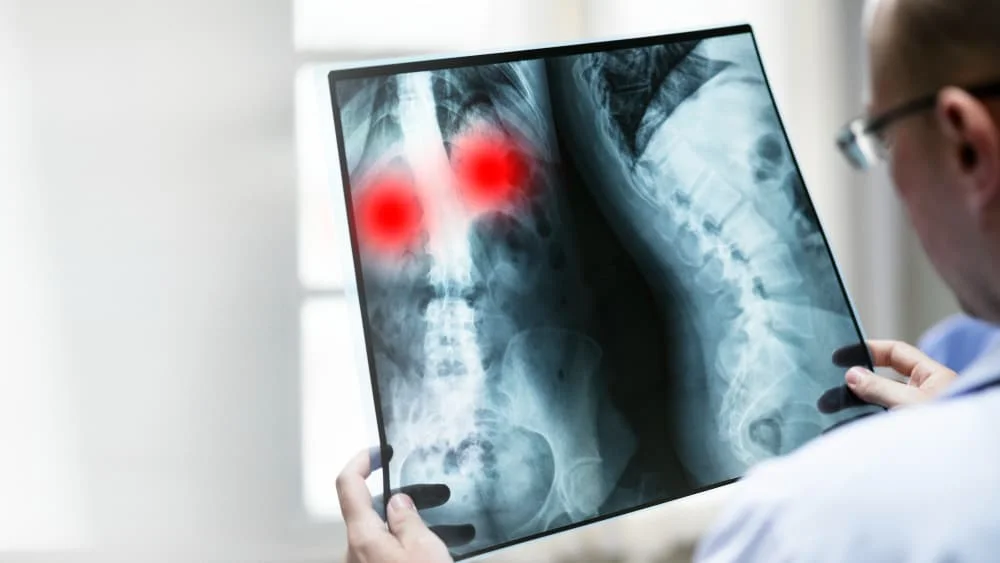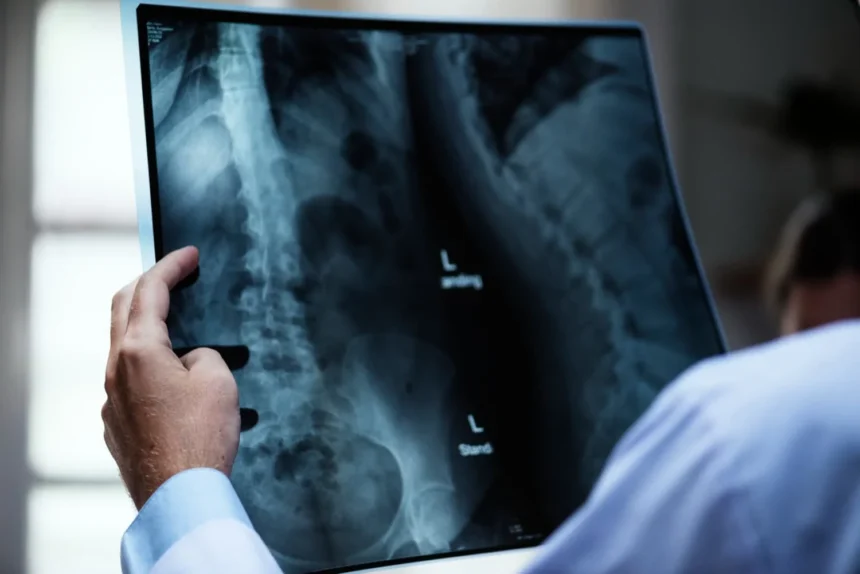Pott’s disease, also known as tuberculous spondylitis, is a serious form of tuberculosis that affects the spine. It occurs when TB bacteria spread from other parts of the body, most commonly the lungs, to the vertebrae. Although it is relatively rare in developed countries, it remains a significant health concern in many parts of the world.
What is Pott’s Disease/Tuberculous Spondylitis?
Pott’s disease, also known as tuberculous spondylitis, is a form of tuberculosis that occurs outside the lungs (extrapulmonary TB) and specifically affects the spine. It is caused by the Mycobacterium tuberculosis bacteria and is a destructive form of spinal arthritis. The bacteria typically spread through the bloodstream from the primary site of infection, most often the lungs, to the bones of the spine.
When the bacteria reach the spine, they usually infect the vertebral bodies, which are the main weight-bearing portions of the vertebrae. This infection can lead to inflammation, bone destruction, and the formation of abscesses. It often begins in one vertebra and then spreads to adjacent vertebrae. The infection may also affect the intervertebral discs, resulting in narrowing of disc spaces and even collapse of the spinal bones.
What is the Most Common Site of TB Spondylitis?
The lower thoracic and upper lumbar spine are the most affected areas in Pott’s disease. This region is particularly vulnerable due to its rich blood supply.
Prompt medical attention is essential for proper diagnosis and treatment, as early intervention can help minimize long-term complications.
Causes and Risk Factors
Pott’s disease is a serious form of tuberculosis that affects the spine. It is caused by the Mycobacterium tuberculosis bacteria, the same organism responsible for TB in the lungs. Although TB primarily targets the lungs, it can spread to other parts of the body, including the spine, a condition known as extrapulmonary TB.
How the Bacteria Spreads
In most cases, the bacteria reach the spine by traveling through the bloodstream or lymphatic system from a primary infection site, usually the lungs. Sometimes, however, the initial infection site may not be clearly identifiable. Once the bacteria settle in the spine, they infect the vertebrae, leading to inflammation, bone destruction, and the formation of abscesses.
Risk Factors
Certain factors can increase the likelihood of developing Pott’s disease. These include:
- Weakened Immune System: Individuals with compromised immunity, such as those with HIV/AIDS, malnutrition, or those taking immunosuppressant medications, are more vulnerable to TB infections, including Pott’s disease.
- Geographic Location: Living in or traveling to areas where TB is prevalent, such as parts of Africa, Asia, and South America, increases the risk of exposure to the bacteria.
- Close Contact: Spending time in close proximity to someone with active TB, especially pulmonary TB, raises the chance of infection.
- Substance Abuse: Intravenous drug use and other forms of substance abuse can weaken the immune system and elevate the risk of TB.
- Other Factors: Conditions such as poverty, overcrowding, and limited access to healthcare also contribute to a higher risk.
Understanding these risk factors is crucial for early detection and prevention, enabling both individuals and healthcare providers to take appropriate steps in managing this serious condition.
Recognizing the Signs: Symptoms of Tuberculous Spondylitis
Pott’s disease can present with a wide range of symptoms from mild to severe. Recognizing these signs early is critical for prompt diagnosis and effective treatment.

The most common and often earliest symptom is back pain. This pain is usually localized to the affected area of the spine and tends to worsen over time. Other common symptoms include:
- Stiffness: Reduced range of motion in the spine.
- Muscle Spasms: Painful spasms in the back.
- Night Sweats: Profuse sweating during the night.
- Fever: A low-grade fever may be present.
- Weight Loss: Unexplained loss of weight.
- Fatigue: A general feeling of tiredness and weakness.
- Neurological Symptoms: When the infection compresses the spinal cord or nerve roots, patients may experience weakness, numbness, or tingling in the legs or feet; in severe cases, there may be loss of bowel or bladder control.
- Kyphosis: A visible spinal deformity marked by an abnormal curvature, often referred to as a hunchback.
- Abscess Formation: In some cases, collections of pus may develop near the spine.
What Happens When TB Spreads to the Spine?
When tuberculosis spreads to the spine, the Mycobacterium tuberculosis bacteria typically infect the vertebral bodies. This leads to inflammation and the destruction of bone tissue, which can cause vertebral collapse and spinal deformity. The infection may also extend to nearby tissues, such as intervertebral discs and surrounding ligaments. If left untreated, spinal TB can result in significant pain, disability, and even paralysis.
What is the Last Stage of Spine TB?
In the advanced stages, untreated spinal TB can be devastating. It may lead to:
- Severe Spinal Deformity: Marked by significant kyphosis or other spinal abnormalities.
- Paralysis: Partial or complete loss of movement due to spinal cord compression.
- Chronic Pain: Persistent and debilitating back pain.
- Abscess Formation with Spread: Large abscesses that may extend to other areas of the body.
- Systemic Complications: The infection may disseminate to other organs.
- Death: In cases where the condition is entirely untreated, it can be fatal.
Early diagnosis and proper treatment are essential for improving outcomes and preventing these severe complications.
Diagnosis of Pott’s Disease
Diagnosing tuberculous spondylitis, involves a careful combination of clinical evaluation, imaging studies, and laboratory tests. Early diagnosis is vital to start prompt treatment and prevent long-term complications.

The Diagnostic Process:
- Medical History and Physical Examination:
Your doctor will begin by taking a detailed medical history, asking about your symptoms, any risk factors for tuberculosis, and previous exposure to TB. A physical examination is then conducted to assess your back pain, spinal mobility, and neurological function. - Imaging Tests:
Imaging is essential for visualizing the spine and detecting abnormalities. Common imaging techniques include:- X-rays: These can reveal signs such as bone destruction and vertebral collapse, although early changes might not be visible.
- CT Scans: These provide more detailed images of the bone structure and can detect smaller lesions.
- MRI Scans: Considered the most sensitive method for detecting Pott’s disease, MRI can show soft tissue involvement, abscess formation, spinal cord compression, and early vertebral changes.
- Laboratory Tests:
To confirm the diagnosis and identify Mycobacterium tuberculosis, several laboratory tests are used:- Biopsy: A tissue sample is obtained, usually via a needle, and examined under a microscope and cultured to identify the bacteria.
- Cultures: Growing the bacteria in a lab provides definitive identification and allows for testing of drug susceptibility.
- PCR (Polymerase Chain Reaction): This rapid molecular test detects the presence of TB DNA in a sample.
A definitive diagnosis of Pott’s disease is established based on the combination of clinical findings, imaging results, and laboratory confirmation of Mycobacterium tuberculosis.
Treatment Options for Tuberculous Spondylitis
The primary goal of treating tuberculous spondylitis is to eliminate the Mycobacterium tuberculosis infection, alleviate pain, prevent further damage to the spine and restore function. Long-term antibiotic therapy is the cornerstone of treatment for Pott’s disease.
AntibioticTreatment usually involves a combination of multiple antibiotics taken over an extended period, typically 6 to 12 months and sometimes longer.
Adherence to the prescribed medication regimen is critical. Even if you start feeling better, it is important to complete the full course as directed. Stopping treatment early or missing doses can lead to drug resistance and treatment failure.

How Do You Treat MDR TB in the Spine?
Multidrug-resistant TB (MDR TB) in the spine presents a significant challenge. Treating MDR TB requires the use of second-line anti-TB drugs, which tend to be more toxic and less effective than first-line medications. The treatment duration is considerably longer, usually 18 to 24 months or more. The specific combination of drugs and the length of treatment are determined based on drug susceptibility testing and your individual response.
Surgical Intervention
In some cases, surgery may be necessary to support antibiotic therapy. Surgical procedures may be required to:
- Drain large abscesses that are compressing the spinal cord or nerves.
- Stabilize the spine when there is a significant vertebral collapse or instability.
- Correct spinal deformities such as kyphosis.
- Remove infected tissue.
Early and consistent treatment is essential for achieving the best possible outcomes. Combining medical and, if necessary, surgical approaches ensure a comprehensive strategy against the disease.
Frequently Asked Questions (FAQs)
How Long Does It Take to Recover from Pott’s Disease?
Recovery from Pott’s disease is often a lengthy process due to the extended course of antibiotic treatment, which typically lasts 6 to 12 months or even longer in some cases. Even after the infection is cleared, additional time may be needed to regain strength, mobility, and function, especially if there has been significant bone damage or neurological involvement. Many patients benefit from physical therapy as an important part of the recovery process.
Can Pott’s Disease Come Back After You Take Medicine?
Although proper antibiotic treatment is generally effective in eliminating the TB infection, there is a small risk of relapse, particularly if the full medication regimen is not completed or if there is underlying immune suppression. It is essential to attend regular follow-up appointments with your doctor to monitor for any signs of recurrence.
Can You Live with TB for Years?
Yes, it is possible to live with TB for years without showing symptoms. This condition is known as latent TB infection, where the bacteria remain in the body in an inactive state. However, latent TB can progress to active TB disease if the immune system becomes weakened. In its active form, such as in Pott’s disease, the infection will produce noticeable symptoms.
What Are the First Signs of Spinal TB?
The earliest sign of spinal TB is typically persistent back pain that does not improve with rest. This pain is usually localized to the affected area of the spine and may worsen over time as the disease progresses.
What Is the Best Treatment for Pott’s Disease?
The primary treatment for Pott’s disease is antibiotic therapy, which is the most effective method for eradicating the TB infection. In certain cases, surgical intervention may also be necessary to stabilize the spine, drain abscesses, or correct spinal deformities.
This information is provided to help you better understand the diagnosis, treatment and management of disease. Always consult your healthcare provider for personalized advice and treatment options.
Can Spinal TB Cause Death?
If left untreated, spinal TB can be fatal, especially when it leads to severe neurological complications, widespread infection, or respiratory failure. With prompt and appropriate treatment, the risk of death is significantly reduced.
Is TB Spondylitis Permanently Curable?
With proper antibiotic therapy, the TB infection itself can be completely eradicated. The goal of treatment is to cure the infection; however, this does not always reverse any existing damage. Some individuals may continue to experience long-term complications, such as:
- Spinal Deformity: Vertebral collapse can lead to kyphosis (a hunchback) or other deformities.
- Neurological Deficits: Compression of the spinal cord may cause permanent weakness, numbness, or paralysis.
- Chronic Pain: Persistent back pain can remain even after the infection has been cleared.
Can Spine TB Patients Walk?
The ability to walk after a diagnosis of spinal TB depends on the severity of the spinal cord or nerve root compression. Early diagnosis and treatment are crucial to prevent irreversible neurological damage. Patients with mild involvement might experience some weakness yet remain able to walk, while severe cases can lead to paralysis.
Can Tuberculous Spondylitis Spread?
Although the infection is mainly confined to the spine, it can spread. The bacteria may extend to adjacent vertebrae, form abscesses that involve nearby tissues, and, in rare cases, re-enter the bloodstream to affect other organs.






